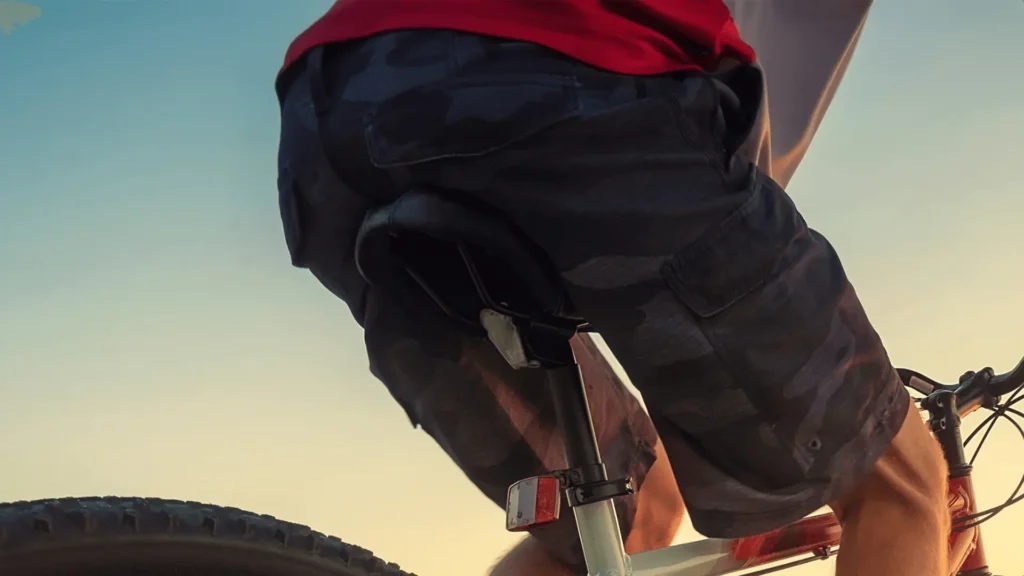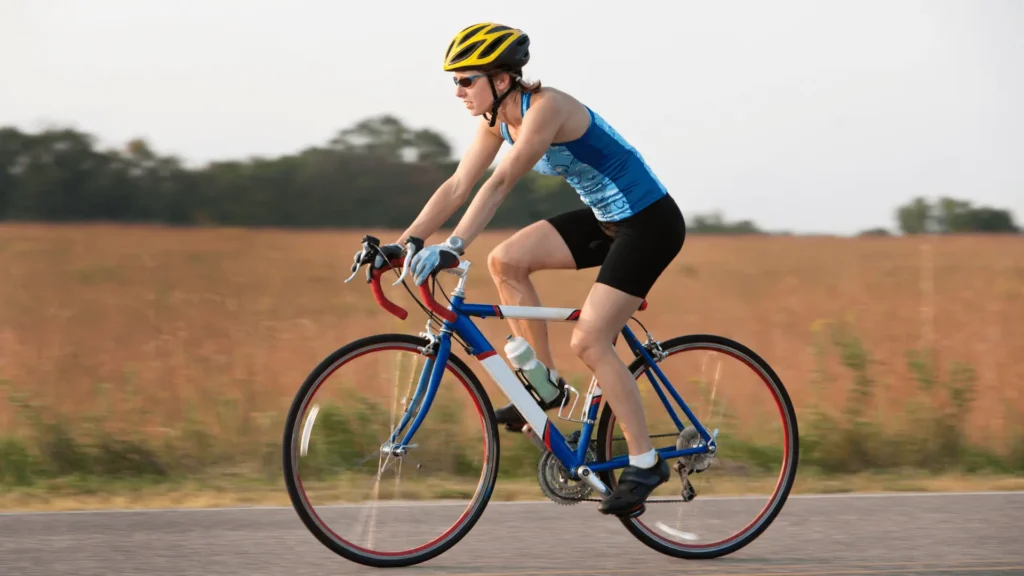Are you experiencing discomfort during your bike rides? Is your saddle causing you pain and making it hard to enjoy the ride? It may be because you’re not sitting on your bike saddle in the right position. Finding the proper seat position is crucial for a comfortable and enjoyable cycling experience.
In this blog post, we’ll discuss everything you need to know about where to sit on your bike saddle, how to find your sit bones, how to adjust your saddle position correctly, and much more! So grab your helmet, hop on that bike, and let’s get started!
Where Should I Sit On My Bike Saddle

When it comes to bike saddles, the most common question is where should I sit? The answer is simple – on your sit bones. Sit bones are the bony protrusions at the bottom of each buttock. They are designed to support your weight while seated and provide a natural cushioning effect.
To find your sit bones, you can perform a simple test called the “sit bone measurement.” Start by placing a piece of cardboard or foil on a hard surface and sit down with your knees at 90 degrees. Stand up and measure the distance between two indentations left behind on the cardboard or foil – that’s your sit bone width.
Once you know your sit bone width, make sure you’re sitting in the right position on your saddle. Your hips should be level, and there shouldn’t be any pressure points causing discomfort. Ensure that you’re not leaning too far forward or backward as this will affect comfort levels.
It’s also important to note that different riding styles require varying saddle positions. For instance, if you ride aggressively in an aerodynamic position, then a slightly higher seat position may work best for you. However, if you prefer an upright riding style for leisurely rides, then a lower saddle height might suit better.
What Is The Best Seat Position on A Bike?

When it comes to cycling, finding the right seat position is critical for both comfort and performance. The best seat position on a bike varies from person to person, depending on factors such as body type, riding style, and personal preferences.
One crucial aspect of seat position is determining your sit bones. These are the bony parts of your pelvis that make contact with the saddle when you’re seated. Finding your sit bones will help you ensure that your weight is evenly distributed across the saddle.
Another important factor in positioning yourself correctly on the bike is sitting on a properly sized bike. If your bike frame is cracked or too big or small for you, it can affect how you fit onto the saddle and ultimately impact your comfort while riding.
Adjusting saddle height can also play a role in achieving optimal seat position. A general rule of thumb is to adjust the height so that at full extension of one leg while pedaling, there’s still a slight bend in the knee.
How To Find Your Sit Bones
Finding your sit bones is crucial for a comfortable and efficient cycling experience. These bones are the bony protrusions at the bottom of your pelvis, where your weight should be distributed when you’re seated on a bike saddle. Here’s how to locate them:
1. Use cardboard or foil: Sit on a piece of cardboard or aluminum foil, and lean forward slightly to put some pressure on the seat.
2. Check for indents: Stand up and look at the impressions left behind – these will show you where your sit bones made contact with the saddle.
3. Measure distance between sit bones: Use a ruler to measure the distance between each indent – this measurement will help you choose an appropriately-sized saddle.
Sitting on The Right Size Bike

Sitting on the right size bike is crucial for your comfort and overall cycling experience. If you’re riding a bike that’s too small or too big, it can cause discomfort and even lead to potential injuries.
To determine if your bike is the right size, start by measuring your inseam. This will help you choose a frame size that fits your body type. It’s also important to consider other factors such as handlebar height and reach.
When sitting on the bike, make sure that both feet are flat on the ground while seated. Your knees should be slightly bent when in a seated position with your feet on the pedals at their lowest point.
It’s also essential to adjust the saddle height according to your leg length. When pedaling, there should be a slight bend in your knee at its lowest point of rotation.
Correctly Changing The Saddle Position
Having the correct saddle position is vital for comfortable and efficient cycling. To begin, loosen the saddle clamp bolt with an Allen key and make small adjustments to its fore-aft position until you find the sweet spot. It’s important to not move it too much at once – a few millimetres can make a big difference.
Next, adjust your saddle angle by loosening or tightening the clamp under your seat using an Allen key. Tilt it slightly upward if you experience numbness in sensitive areas or downward if you feel like you’re sliding forward on the saddle.
It’s crucial to also consider your handlebar height when adjusting your saddle position. Make sure that both are set so that neither puts too much pressure on any particular body part.
Keep in mind that changing your saddle position will affect how efficiently power is transferred from pedals into wheels. Therefore, it may take some trial and error before finding what works best for you!
Put Your Hands on The Handlebars
One important aspect of finding the best seat position on your bike is to put your hands on the handlebars. This helps you determine whether you are leaning too far forward or sitting up too straight.
When you reach for the handlebars, make sure that your arms and shoulders are relaxed. You don’t want to be hunched over or have your elbows locked in place.
If you find yourself reaching too far forward, try adjusting the saddle height or moving it back slightly. This can help bring your body into a more comfortable position.
On the other hand, if you feel like you’re sitting up too straight, adjust your saddle height upward or move it forward a bit.
Factors Which Will Affect Your Comfort

Your comfort while riding your bike is crucial, not only to fully enjoy the experience but also to avoid potential injuries. Several factors can affect your comfort level, and it’s essential to consider them when deciding where to sit on your bike saddle.
One of the main elements that will impact how comfortable you feel on your bike is the size of your bicycle. Riding a bike that doesn’t fit properly can cause discomfort or pain in different parts of your body such as back, neck, shoulders or wrists.
The saddle height also plays an important role in determining whether you’ll be comfortable during rides or not. A seat that’s too high or too low may cause issues with pedaling efficiency and lead to knee pain.
Getting a proper bike fit is key for optimal comfort levels while cycling. A professional fitting session can help you find the right saddle height, reach distance and handlebar position based on your body measurements and riding style.
Size of Your Bike
When it comes to finding the right seat position on your bike, one important factor to consider is the size of your bike. Riding a bike that’s too big or too small can lead to discomfort and even injury.
To determine if you’re riding the right size bike, start by measuring your inseam. This will give you an idea of what frame size to look for. Keep in mind that different brands may have slightly different sizing guidelines.
It’s also important to consider the geometry of the bike. A more upright position may be more comfortable for some riders, while others prefer a more aggressive, aerodynamic stance.
Once you have the right size bike, make sure your saddle height is adjusted properly. Your leg should be almost fully extended at the bottom of each pedal stroke without being completely locked out.
Saddle Height
When it comes to bike saddle position, getting the height right is crucial for both comfort and performance. A saddle that’s too high can cause discomfort in your knees and hips, while one that’s too low can negatively affect power output.
To find your ideal saddle height, start by standing over the bike with both feet on the ground. Then, lift one leg so that your knee is level with your hip. Measure from the ground to the top of your inseam at this point – this measurement will give you a good starting point for setting saddle height.
However, keep in mind that there are other factors to consider when determining the perfect saddle height for you. Your riding style and flexibility will play a role as well.
If you’re new to cycling or experiencing discomfort during rides despite adjusting your seat height, it may be worth investing in a professional bike fit. A trained expert can analyze everything from your pedal stroke to body positioning and help you achieve optimal comfort and performance on two wheels.
Get a Proper Bike Fit
Getting a proper bike fit is crucial for your comfort and performance while cycling. A poorly fitting bike can cause discomfort, pain, or even injuries.
The size of your bike plays an important role in getting the perfect fit. Make sure that the frame size is appropriate for you by checking if you can comfortably stand over it with both feet flat on the ground.
Saddle height is also essential to consider when getting a proper bike fit. Your saddle should be adjusted so that when your pedal is at its lowest point, there’s a slight bend in your knee.
Another factor to take into account is handlebar placement. The correct position will reduce strain on your neck and shoulders while providing stability and control.
Consulting with a professional fitter can help ensure that all these aspects are taken care of properly. They’ll assess your body measurements, flexibility, riding style and make adjustments as necessary to give you optimal comfort and efficiency during rides.
Choosing The Right Saddle

When it comes to cycling, the saddle is one of the most important components of your bike. A poorly chosen saddle can make even a short ride extremely uncomfortable, while a well-chosen one will allow you to cycle for hours on end in comfort. Here are some things to consider when choosing the right saddle:
The three main types of bike saddles are road, mountain, and leisure/hybrid. Each type is designed with different features that cater to specific riding styles.
Road saddles are typically long and narrow with minimal padding, ideal for riders looking for speed and performance. Mountain bike saddles tend to have more cushioning and support due to their off-road nature.
Leisure/hybrid saddles offer a balance between speed and comfort as they feature a wider shape with extra padding intended for recreational cyclists who want maximum comfort during their rides.
The Three Main Types of Bike Saddles
When it comes to bike saddles, there are three main types available on the market. The first type is the racing saddle which has a narrow shape and minimal padding. It’s designed for people who want more speed and less weight, but may not be suitable for long rides or those with wider sit bones.
The second type is the mountain bike saddle which is wider than a racing saddle and usually has more padding. This type of saddle offers extra comfort when riding off-road routes where you may encounter bumps and rough terrain.
There’s the touring or commuting saddle which is even wider than a mountain bike saddle and provides maximum comfort for longer rides. This kind of seat often features gel inserts or springs to absorb shock from uneven surfaces.
Choosing the right bike saddle can make all the difference in your cycling experience. It’s important to consider your riding style, body type, and preferences before selecting one that works best for you.
How To choose A Bike Saddle Based On Your Riding Style
Choosing the right bike saddle is crucial to ensuring that you have a comfortable ride. However, with so many options on the market, it can be overwhelming to know which one is best for your specific riding style.
Firstly, consider the width of the saddle. If you are an avid road cyclist who enjoys long rides and spends most of their time in an aggressive position, then a narrow saddle may be more suitable for you. On the other hand, if you enjoy leisurely rides or mountain biking where your body weight is shifted back on the seat, then a wider saddle would be better.
It’s also important to think about padding levels. A highly padded saddle may seem like a good choice at first but can actually cause discomfort during longer rides as they tend to compress over time. If you prefer shorter rides or off-road cycling where bumps are more frequent and require added cushioning, then a well-padded saddle might suit your needs.
Another factor to consider when choosing a bike saddle based on your riding style is its shape and curvature. For those who ride aggressively with forward-leaning positions that put pressure on their pelvis area, saddles with cutouts or channels down its center could relieve pressure points and improve circulation.
Conclusion
Finding the perfect seat position on your bike saddle can make a significant difference in your riding comfort and overall cycling experience. By following the tips outlined in this article, you will be able to find the right seat position that fits you perfectly.
Don’t hesitate to experiment with different positions until you find one that works best for you. Cycling should be an enjoyable activity, so always prioritize comfort and safety while riding on two wheels. Happy cycling!






